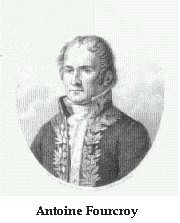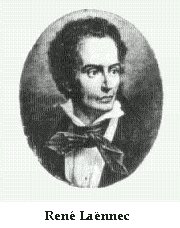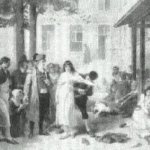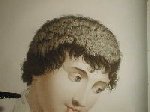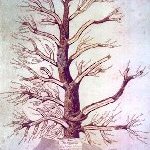Choosing a dermatological hero for the millenium
by Daniel Wallach,
French Society for the History of Dermatology, Paris
Joint meeting of the sections of Dermatology and History,
Royal Society of Medicine, London, February 25, 1999
 The historical context of Alibert’s career : the French revolution and medicine
The historical context of Alibert’s career : the French revolution and medicine
Alibert’s career took place at a time of intense political and cultural turmoil:
the French revolution brought dramatic changes to all the fields of public life, including medicine.
To briefly summarize a very tumultuous but creative period,
The National Assembly, in a move towards equality between all citizens, abolished all corporations and teaching institutions. So the Faculté de médecine, which had indeed many problems and was unanimously viewed as sclerotic and hidebound, was closed, as well as the académie de chirurgie, in August 1792.
But shortly after this suppression, the foundation of new schools to teach medicine appeared unavoidable:
- in the whole country, quacks had replaced doctors and done much harm, leading to complaints from the people ;
- more importantly in this time of war, many physicians, medical doctors, surgeons, health officers, had followed the armies, hundreds of them had been killed and they had to be replaced.
The rebirth of the schools of medicine led not only to the reconstruction of what the Revolution had destroyed, but to a very significant progress in the entire organization of French medicine.
The decree creating the Ecoles de Santé, voted by the National Assembly, the Convention, on the 4th of December 1794, 14 frimaire an III according to the Revolutionary calendar, is considered as the moment of birth of modern medicine in France. It was prepared by Antoine Fourcroy, a very brilliant teacher who completely renewed public education. Three » Ecoles de santé » were created in Paris, Montpellier and Strasbourg (they will be renamed, in less revolutionary times, Facultés de Médecine). The principles of this new medical education created by the an III decree were:
- Unification of medicine and surgery
- Practical teaching in the hospitals : Fourcroy said : » Read a little, see much, do much « .
- Scientific formation, including natural history, chemistry, physics, pharmacy
- Recruitment of deserving students ( » Pupils of the Nation « ) in all French districts.
Alibert was one of these students of the new Ecole de Santé.
Most importantly, this decree gave impetus to what will later be called « Hospital Medicine », a medicine which gave priority to clinical teaching. This led to the emergence of a generation of outstanding physicians, known as the Paris school, whose reputation dominated all the medical world during the first half of the nineteenth century. The best known were Bichat, Laennec, Broussais, Corvisart ; and Alibert was one of them.
The idea of a Paris School of medicine was made popular by the book by Erwin Ackerknecht, first published in 1967 ; it is also important to cite Michel Foucault, the well-known contemporary French philosopher. In « Birth of the Clinic », written in 1963, Foucault successfully explained the philosophical and epistemological importance of this period. In particular, Foucault emphasized the importance to the Paris school of « the sovereignty of the gaze ». The way dermatologists started to look at the skin is one of the best examples of this new medical gaze. Alibert is indeed the first example in France of a physician
- looking at the skin diseases,
- describing skin diseases,
- representing skin diseases in the paintings and engravings of huge, expensive atlases.
Alibert’s early career
Jean-Louis Alibert was born on May 2, 1768, in Villefranche de Rouergue, a small town in Southwest France. His father was a local magistrate.
Alibert studied in Villefranche, then inToulouse in schools of the Fathers of Christian Doctrine, one of the best known of the educating religious orders.
He studied mainly philosophy, literature, greek, latin and theology and might have even begun a religious career as a novice. But the Revolution intervened, and the religious teaching orders were suppressed. This suppression may have been welcome by the more progressive teachers and students, who were followers of modern philosophical ideas.
Alibert thus came to Paris; he first attended the Ecole Normale, a school created by the Convention with the best professors of the time; the students were to become teachers (Alibert seems to have been a teacher himself some time before) and to spread through the whole country as « schoolmasters of the people ». But the mentality was said to be too revolutionary for the political leaders and the School did not last more than several months, during the year III (1794).
In Paris, Alibert was surrounded by the most brilliant young literary intellectuals ; he socialized in the brilliant salon of Madame Helvetius, where he met, among other celebrities, Pierre-Georges Cabanis, a philosopher, writer and physician, and a man of great political influence.
After the closing of the Ecole Normale, Alibert entered the newly created Ecole de Santé. He had probably been inspired by the medical career by his friend Cabanis.
This school had outstanding Professors, such as Pinel, Desault, Corvisart, and it appears that a truly scientific and modern approach was common among teachers and students. Desault, the teacher of Bichat, was the first Professor of Clinics in Surgery at L’Hotel-Dieu, and Corvisart, later the physician of the Emperor Napoleon, was the first Professor of Clinics in Medicine at La Charitété. Alibert’s Dermatological Clinics, the first specialized clinics, were inspired by these professors.
While still a medical student, Alibert started writing medical papers, as well as many philosophical and medico-literary works. We will not go into details about the non-dermatological part of Alibert’s works, but it is important to know that he was one of the most brilliant writers of philosophical or literary medicine, with books such as « Physiologie des Passions », a treaty of moral psychology. One of the consequences of this scientific enthousiasm was the foundation in 1796 of the Société Médicale d’Emulation, a sort of Research Society. Though still a student, Alibert was probably behind its founding. He was its first Secretary, and he wrote many papers for the Bulletin of the Society.
Alibert’s medical thesis on Pernicious fevers was prepared in the medical department headed by Pinel in 1799. Philippe Pinel, both a philosopher and a physician, is best known for having liberated the insane from their chains at Bicêtre and La Salpetriére.
Pinel created modern psychiatry ; but at the center of Pinel’s medical thought was the nosological classification of diseases. He published in 1798 a « Nosographie philosophique » which remained influential for many years. Although Alibert did not follow all of Pinel’s ideas, he was influenced by Pinel, and also wrote, later, a « Nosologie naturelle ».
Thanks to his talent and activity, and probably thanks to the political influence of Cabanis, Alibert was nominated in 1801 Médecin-adjoint de l’Hôpital Saint-Louis, at this time l’Hospice du Nord.
L’Hôpital Saint-Louis
The Hôpital Saint-Louis was built in 1607 by King Henry IV. At this time the plague reoccurred approximately every ten years and the Hotel-Dieu, at the center of Paris, could not take care of all the patients. The new hospital was built outside Paris for the purpose of receiving these contagious patients. The patients were kept in four wards, and soldiers and guard-dogs were posted to prevent them from escaping. The buildings, still intact to-day, are a magnificent example of early seventeenth century architecture ; the other example in Paris is the Place des Vosges.
In 1773, the old Hotel-Dieu burned and L’Hôpital Saint-Louis was opened on a permanent basis. Far from the center of Paris, it was neglected and mostly sheltered patients with ulcers, both of traumatic or medical origin. Ulcers were considered chronic diseases for which a daily visit was not necessary. Needless to say, only the very poor entered the hospital at this time. And, as said earlier, there were no students and very few doctors to take care of them.
At the end of 1801, the Hospital administration officially dedicated the hospital to chronic diseases, either contagious or cachectic. This vague definition encompassed more or less all chronic skin diseases, such as scabies, tinea, tetter, scurvy, and ulcers of all origins.
So Alibert was in charge, as he said himself, of a « cloaque », a « cesspool » that he regarded as a promising field for scientific investigation.
The main influences of Alibert’s medical thought.
Although Alibert claimed that he entered the field of skin diseases as a pioneer, and although he did not often refer to earlier works, some important influences may be found in his medical approach.
The sensualist philosophy.
The sensualist philosophy prioritizes what our senses can perceive. Locke and Condillac founded this philosophy and Cabanis applied it to medicine, arguing that clinical observation is the very essence of medicine.
Clinical diagnosis, exemplified by Laennec with auscultation, and by Alibert with the description of skin diseases, was the medical derivative of the sensualist philosophy.
By giving priority to observation, as opposed to theoretical thinking, sensualist and revolutionary physicians returned back to the hippocratic tradition, which also gave first place to what the five senses of the doctor can perceive. They rejected theoretical medicine, and systematic medicine, medicine based on preconceived systems.
Hospital medicine
As we said, the close relationship that now exists between hospitals and medicine only begun after 1794. Before, hospitals were shelters for the homeless. After, they became the field of scientific medicine.
Jean-Louis Alibert, in contrast with Plenck, a librarian dermatologist, and Willan, who only saw out-patients in a dispensary, worked with in-patients in a hospital.
There was also an outpatient department at Saint-louis, but about 600 beds were permanently occupied by patients with skin diseases.
The fact that Alibert was able to follow day after day the evolution of skin diseases gave him the idea that the type of evolution was important for the description and classification of skin diseases. It also probably reinforced his opinion that skin diseases should be considered part of internal medicine, according to the hippocratic conception of skin diseases.
One can also see that the representation of skin disease in Alibert’s atlases always included the entire person with physionomy and clothes, and not only a part of the skin with a lesion. This is the iconographic counterpart of the natural method.
The botanist method.
Alibert lived at a time when all sciences were quickly progressing. Progress in the natural sciences was particularly evident. Most of all, botanists were much admired because they had succeeded in establishing a classification of plants.
Charles Linné had first tried to form natural groups of plants ; but he did not succeed and adopted a more simple method, called « artificial », where the main criterium was the number and distribution of sexual organs, stamens and pistils. Linné was also the first to generalize the binary denomination of plants, that Alibert followed for skin diseases.
Other botanists proposed classifications called « natural », that is to say a classification based not only on one, but on many characteristics of the plants, such as appearance, height, diameter, …. Bernard and Antoine de Jussieu were the most successful in this » Natural method « . Jussieu first individualizes the Species, then according to analogies gathers together Species in Genders, then Genders in Orders or Families, then Families in Classes.
Alibert’s main achievements
The teacher
Alibert became famous because he was a great teacher. As soon as he arrived in Saint-Louis, he started clinical lessons.
In doing so, he translated to dermatology the clinics which had been established with great success by his Professors at the Ecole de Santé, Desault and Corvisart.
Alibert’s clinic soon attracted not only students but also well-known physicians, foreigners and fahionable people. The lecture hall in the Pavillon Gabrielle became too small and, following the example of the Ancient Greek philosophers, Alibert etablished his clinic in the open air, under the lime trees near the Pavillon Gabrielle.
There are many testimonials to the personality of Alibert and the ambiance of these clinics.
One painting by René Berthon, dated 1811, represents the « Lesson at the Hôpital Saint-Louis ». Alibert was standing on a wooden platform and the audience was sitting on benches. Paintings of various skin diseases, and probably later a painting of the Tree of the Dermatoses, were suspended from the trees. The patients bore placards indicating the diagnosis in 5-cm letters. Alibert called patients « on stage » by the name of their disease : « Come up, dartre veroleuse! ».
Alibert described the skin diseases in a theatrical way, with his pleasant southern accent, and his lectures were filled with metaphors and original humour. The best example is the one of a syphilitic prostitute, presented as « a priestess of Venus, wounded by the perfidious dart of love ».
Although this way of presenting patients to the public seems to bear little respect for patients, Alibert was famous for his generosity and benevolence. He used to pick up sick people he met in the streets in his coach to bring them to the hospital, at least if they had a skin disease.
The describer
Alibert not only described skin diseases orally, he also wrote impressive books. Alibert’s books were very innovative in several ways : they described many skin diseases, they were written in French, and not in Latin, they were large format, huge in-folio, and they were beautifully illustrated with many painted figures.
Consequently these books were very expensive. Alibert, who had married the daughter of his publisher, is said to have spent her dowry to print the books. They were too expensive for students and Alibert also published smaller, less-illustrated, cheaper books.
In fact, Alibert wrote two main books on dermatology: one during his first period at the Hôpital Saint-Louis, and the second one fifteen yeas later.
The first one is the « Description des maladies de la peau observées à l’Hôpital Saint-Louis, et exposition des meilleures méthodes suivies pour leur traitement ». It was published from 1806 to 1814, with 53 color plates and represents all the work of Alibert in is first hospital period.
La » Description… » contains many valuable descriptions of skin diseases, including the first description of mycosis fungoides, that at this time Alibert called « pian fongoà¯de ».
Diseases are arranged in a » classical » order, starting with diseases of the scalp, les Teignes (Tinea) and les pliques, followed by the diseases of the whole body, arranged in an arbitrary order.
Alibert is credited with the first descriptions of :
- Mycosis fungoides, first called Pian fungoides, and observed only in one patient, named Lucas
- Amiantaceous tinea, later called Porrigine amiantacïése, with the typical nomenclature change which was blamed on Alibert.
- Keloids
- Cutaneous leishmaniasis, in patients from North Africa. Alibert insisted on the fact that L’Hôpital Saint-Louis was opened to skin sufferers from the whole world ; he wanted to have the motto « Urbi et orbi » written on the door.
- Dermatolysis, with a spectacular observation of a shepherd.
Alibert invented many terms with Greek or Latin bases. Most of them were confusing and useless but two became famous: dermatoses and syphilides.
The discoverer of causes
Alibert was a talented describer but he never thought that the clinical description is the ultimate goal in medicine. He explored all that could be brought at his time by pathology, chemical analysis.
Alibert tried to resolve the question of contagion of some dermatoses by using inoculation, not only on animals, but also on himself and his pupils.
On October 17, 1808, Alibert inoculated to himself and three of his students, Le Noble, Fayet and Durand, the substance taken from a breast cancer. None of them got cancer, but local suppuration. Seven days later, he inoculated again himself and also his favorite pupil Biett. Biett got transient lymphangitis. Similar negative experiments were performed with various dermatoses, such as herpes and tetters (dartres).
The name of Alibert is tightly associated with one great medical event: the discovery of the etiology of scabies. This is a long and agitated story, which lasted from 1812, when Galès claimed he had succeeded in showing the « fabulous insect » to 1834. In this « acarus controversy », Alibert was the one who believed in the responsability of the acarus in scabies, while others, like Lugol, denied it.
On August 13, 1834, Renucci, a student from Corsica, who had learned it from the old women in his native island, showed to the entire staff at Saint-Louis how to extract the acarus from the skin of patients with scabies. This demonstration met with much success and was published in la Gazette des Hôpitaux three days later. This event has a very important place in all the history of medicine because it was the first time that the specific cause of a disease was identified. The etiology of tinea would be found only some years later by Schoenlein.
Alibert had not waited until the demonstration of 1834 to indicate that insects were associated with scabies: in his 1814 Description, a drawing of scabies with insects is given as « Psoride pustuleuse vulgaire », psoride meant pruritic dermatose. In La Clinique, in 1833, the same drawing and the same insects were now named « Gale légitime, ou vésiculeuse », a part of the group of the scabetic dermatoses.
The important thing is that skin diseases may have causes, and that it is worthwhile to look for causes. The cause is, according to Alibert, the first criterium in classifying skin diseases. But in his time, almost no cause was known.
The therapist
Therapy had always been a major priority in Alibert’s work. He wrote many papers and books on therapeutics, the most important of which were « New elements of therapeutics », which went through five editions between 1804 and 1826, « The Art of formulation », and a « Historical handbook on mineral waters ».
The full titles of the two great atlases, La Description … in 1814 and La Cinique … in 1833 also include the treatment of the skin diseases.
Of course therapeutics at this time was almost never effective in the modern sense, and it is no use citing here the treatments used by Alibert. However it is important to underline Alibert’s attention to therapy. It is a traditional criticism at dermatologists that they neglect therapy. Alibert never neglected therapy ; indeed, he was made Professor of Therapeutics at the Faculté de Médecine in 1823.
Alibert, physician of the Kings.
There are two periods in Alibert’s activity at l’Hôpital Saint-Louis:
The first period, between 1801 and 1815, the whole Napoleonian era, culminated with the publication of La Description …. and its smaller counterpart, the cheaper Précis.
At this time, after Napoleon’s defeat, there was the Restoration of the Royalty with King Louis XVIII. The king admired the Description and appointed Alibert his personal physician.
Alibert became physician of the king, which meant a brilliant social position. It was also a difficult job, because the king was not in good health and his doctor was often needed.
After the death of Louis XVIII, King Charles X kept Alibert as Physician ; he rewarded him by naming him as Baron.
But during all these years, royal service and private practice had kept Alibert from his duties at the Hôpital Saint-Louis; he had left his department to Laurent-Théodore Biett, a Swiss-borne phsician, his best pupil.
In contrast to Alibert, Biett was a rather dull, serious-looking man, who wrote little. But he was a well-liked teacher.
In 1816, Biett had the opportunity to go to London with a patient. He attended Bateman’s clinic in Carey Street Dispensary and was introduced to the Willan-Bateman method of clinical diagnosis based on the anatomy of lesions. When he returned to Paris, in his teaching he adopted this method for diagnosis and also as a basis for the classification of skin diseases. Other French physicians, like Rayer, did the same.
Alibert’s last years, the Tree of the dermatoses and the controversy about the nosology of skin diseases.
The classification of diseases is a longstanding problem in the philosophy of medicine.
The nature of diseases as distinct entities and the justification of classifications has been defended by many authors, like Sydenham, Boissier de Sauvages, Pinel, and denied by others, like Broussais. Alibert himself wrote in 1817 the first volume of a « Nosologie naturelle », in which diseases are classed by organ. Although this anatomical classification was rather logical and in accordance with the new ideas of the anatomists and the anatomo-clinical method, Alibert’s nosology met with little success and the second volume was never published.
As regards skin diseases, there are many systems of classification:
- they could be classified as internal or external ; this was Hippocrates’ first approach, and was also followed by Lorry.
- Mercuriali, followed by Turner, distinguished between diseases of the scalp, called tinea, and diseases of the rest of the skin, called tetter (dartres in French). In his first book, Alibert followed this order.
- The classification according to the elementary lesions, or the anatomy of primitive lesions, was invented by Plenck and developed mainly by Willan and Bateman. This clinical method had the great advantage of allowing easy clinical diagnosis and this » artificial » classification was widely accepted, particularly in France. Some of the French followers of Willan thought they could oppose this approach to Alibert’s but this was not the opinion of Alibert himself.
- Alibert believed that to classify skin diseases adequately, or rather to group them together, one must not take into account a single criterium, but many
- Cause, when it is known
- Course, as it can be better observed in hospitalized patients,
- Duration,
- Appearance, which may be assimilated to the anatomy of the lesions
- Response to therapy.
This altogether is called « the natural method ».
Alibert gave full tribute to Willan’s works in his precise descriptions of the lesions, but he thought that the elementary lesions are only one part of skin diseases, and not the totality of the diseases. So he classified diseases without giving priority to the clinical description.
In 1829, when Alibert, already aged 61, resumed his clinical lessons in Saint-Louis, times had changed : a young and appreciated teacher was giving lessons according to another doctrine. Alibert decided to apply himself to a new presentation of his entire thought on skin diseases. He wanted to apply the « natural nosology » to skin diseases.
He had worked for two years, with young physicians who had to describe precisely the patients and do some research, with painters for the plates, with classicists for the denomination of the diseases.
To better represent the result of his work, Alibert decided to imitate the Tree of Fevers, with which Torti had represented all the fevers, and he built the Tree of the Dermatoses, with
- Branches to figure groups,
- boughs to figure genders, and the
- smallest branches the species.
After these two years of work in secret, Alibert gave a much awaited opening lesson, on April 26, 1829. After general considerations, he explained that he had conceived genealogical tree to present both the dermatoses in a regular order, and also a new nomenclature. Alibert said he wished to present a method, not a classification. Nevertheless it is clear that his Dermatological Tree is in fact a kind of classification.
In a theatrical gesture, Alibert unveiled his Tree and received congratulations from his friends.
But a few days later, on May 14, Biett, his former student, and a rival, gave his own opening lesson. He indicated that he had found the willanist method clearer, easier to use and more natural.
And this was true: Alibert’s classification of skin diseases is useless. It is so strange, seems so filled with errors that it can be of no use for the clinical dermatologist:
As an example, Eczema is not a part of the eczematous dermatoses, psoriasis can be found nowhere, although they had been precisely described by Willan, Bateman and their followers many years before La Clinique.
The last years of Alibert’s life were devoted to the defense of the natural method, as opposed to the willanist artificial method. But in this conflict, the willanists led by Biett were apparently the winners.
As Hardy, a very influential dermatologist of the second half of the century, later said:
« We had fun with Alibert, and education with Biett ».
The issue of the classification of skin diseases is of the greatest importance when examining Alibert’s contribution to dermatology. It is usually assumed that Alibert compared diseases to plants. But Alibert clearly knew, and wrote, that it is not possible to compare diseases to any concrete thing or living being:
« One must not ignore that the divisions called Species in nosology can in no way be assimilated to what the naturalists call Species. Here are only abstractions useful in helping the combinations of our mind, and which separate facts only to allow us to evaluate their analogies and differences ».
For Alibert, there can be no classification of skin diseases, or of diseases in general, but there is a need for some order or grouping of the clinical observations.
In attributing such a modest place to classification, Alibert seems to denegate the efforts of his master Pinel and himself to establish a classification of diseases. But he was also in accordance with Broussais, who violently fought against « classifying despotism » and proposed that individual diseases did not exist, that all pathological states were a consequence of intestinal inflammation. Broussais’s influence can be found in the last classification of Alibert, where inflammatory, or eczematous dermatoses, form the first group of dermatoses.
In fact, Alibert was right in describing skin diseases, but he was wrong, and probably he knew he could not be right, in proposing a classification, or a grouping, of these diseases.
In conclusion
What made Alibert famous also made him fail. The spectacular representation of the tree of the dermatoses, its impact, made Alibert known worldwide.
But the tree was ahead of its time: it was impossible at this time to classify all skin diseases on a logical basis. And almost two hundred years later, it is still impossible.
In Rook’s most famous textbook for example, you still find a chapter on bacterial infections and a chapter on bullous eruptions. To what tree could one attach these two branches ?
Alibert is still ahead of our time.

